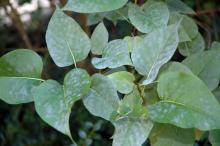Cause The fungus Erysiphe syringae (formerly Microsphaera syringae) is found generally and can also infect Privet (Ligustrum spp.). Phyllactinia syringae has been reported from Idaho and E. penicillata has been reported from WA. Cultivars of S. vulgaris are very susceptible, but other species can be resistant. Conidia are released in response to abrupt decreases in relative humidity. Wind blows conidia to healthy foliage where they start new mildew colonies. Too much water, such as flowing water or rain, destroys spores by causing them to burst. The fungus does not grow in a leaf but rather across the surface. Small anchor cells of the fungus, haustoria, remain in the leaf and take nourishment from the plant, but the main filament and the multitudes of spores it produces are outside the leaf. The disease can develop under relatively dry conditions in spring and summer so long as the air is humid. Plants in shade tend to have more problems because that environment favors disease development. Multiple disease cycles occur during the growing season.
The following species and cultivars were found to be resistant to both powdery mildew and bacterial blight in Tennessee: Syringa josiflexa 'Royalty', S. patula 'Miss Kim', S. prestoniae 'Donald Wyman', and S. vulgaris 'Sensation'.
Symptoms A grayish-white fungus develops at first in patches but then extensively on leaves. Generally the disease does not appear until the latter part of the growing season and so does little damage.
Cultural control
- Space plants or prune branches for good air circulation.
- Do not plant in shade.
Chemical control Use just before symptoms are expected or when they first appear. Alternate or tank-mix products from different groups that have different modes of action. Limit the use of any one group during crop production.
- Armada 50 WDG at 3 to 9 oz/100 gal water. Do not use a silicone-based surfactant. Not for nursery or greenhouse use. Group 3 + 11 fungicide. 12-hr reentry.
- Compass 50 WDG at 1 to 2 oz/100 gal water. Do not use organosilicate additives. Group 11 fungicide. 12-hr reentry.
- Concert at 22 to 35 fl oz/100 gal water. May cause injury to buds, blooms or tender new growth. Landscape use only. Group 3 + M5 fungicide. 12-hr reentry.
- Daconil Weather Stik at 1.38 pints/100 gal water. Although registered, other compounds would likely be more effective. Group M5 fungicide. 12-hr reentry.
- Eagle 20 EW at 6 to 12 fl oz/100 gal water. Group 3 fungicide. 24-hr reentry.
- Heritage at 1 to 4 oz/100 gal water plus a non-silicone-based wetter sticker. Group 11 fungicide. 4-hr reentry.
- Insignia SC at 3 to 6 fl oz/100 gal water. Do not use with organosilicate-based adjuvants. Use preventively only. Group 11 fungicide. 12-hr reentry.
- Mural at 4 to 7 oz/100 gal water. Group 7 + 11 fungicide. 12-hr reentry.
- Myclobutanil 20 EW T&O at 6 to 12 fl oz/100 gal water plus spreading agent. May observe a PGR effect. Group 3 fungicide. 24-hr reentry.
- Pageant at 6 to 12 oz/100 gal water. Do not use with organosilicone-based adjuvants. Group 7 + 11 fungicide. 12-hr reentry.
- Pipron LC at 4 to 8 fl oz/100 gal water plus a surfactant. Greenhouse use only. Group 5 fungicide. 12-hr reentry.
- Propiconazole-based products. Group 3 fungicides.
- Banner MAXX at 5 to 8 fl oz/100 gal water. 12-hr reentry.
- Infuse Systemic Disease Control at 2 Tbsp/gal water. H
- ProCon-Z at 5 to 8 oz/100 gal water. 24-hr reentry.
- Orkestra at 6 to 8 fl oz/100 gal water. Group 7 + 11 fungicide. 12-hr reentry.
- Safer Brand Garden Fungicide (Ready To Use 0.4% sulfur) thoroughly sprayed over the entire plant. Do not use when the temperature is over 85°F or within a few weeks of an oil spray. H
- Seido at 4 to 5 fl oz/100 gal water plus an adjuvant. Group 50 fungicide. 4-hr reentry.
- Spectracide Immunox Multi-Purpose Fungicide Spray Concentrate for Gardens at 1 fl oz/gal water. Group 3 fungicide. H
- Tourney EZ at 1 to 4 oz/100 gal water. Group 3 fungicide. 12-hr reentry.
Biological control
- Cease or Rhapsody (Bacillus subtilis strain QST 713) at 2 to 8 quarts/100 gal water. Active ingredient is a small protein. Efficacy in the Pacific Northwest is unknown. 4-hr reentry. O
Reference Mmbaga, M.T., Sauvé, R.J., Nnodu, E. and Zhou, S. 2005. Multiple disease resistance to powdery mildew, bacterial blight, and alternaria blight in lilacs (Syringa spp.). Journal of arboriculture 31:1-9.



